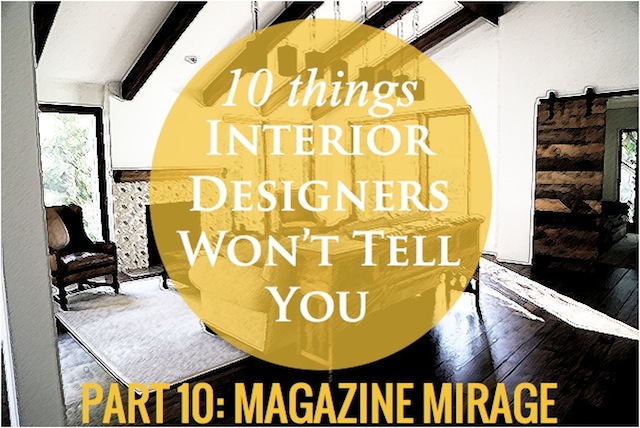THE BUSINESS OF DESIGN: MAGAZINE MIRAGE
Here we are with the final installment of 10 Things Interior Designers Won't Tell You based on the article by the same name. Read more about this series by beginning at Part 1.
MY WORK IN ARCHITECTURAL DIGEST IS A MIRAGE
Showplace homes in glossy magazines are great showcases for designers. It stands to reason that they will work hardest to get the best pieces for those deep-pocketed, high-profile clients who can get them spreads in "wish books" such as Architectural Digest or even in the "home" section of regional newspapers. While it's a good idea to peruse your favorite shelter magazines for ideas, remember that there are only so many great pieces of vintage Stickley to go around.
Additionally, the photographs you see in the publications have probably been enhanced in one way or another. "Frequently, the photographer moves a chair or adds a few details because the camera lens can only see so much of the room," says Schlattman, who has had her designs profiled in a number of magazines. "But it's usually not a major to-do."
The same holds for a designer's portfolio photographs. A little fancy lighting here, a few artfully placed flowers there, and you can produce a room that's a whole lot nicer on the page than in reality.
A better approach is to ask for names of clients who've hired the designer and then go see their homes for yourself. That way, you can talk to the references in the flesh -- usually more effective than a phone call for getting honest answers or determining whether the person is someone whose opinion you trust in the first place. Make sure to ask what was done by the designer, and what existed before. You should also ask whether the designer stuck to his budget, and where problems -- if any -- surfaced.
We all know that what we see on tv or in magazines is enhanced, right? This shouldn't be a big surprise to anyone that when you are looking in magazines, it is the room looking its very best. If you were going to be in a magazine, you'd want the best light, the best photographer, makeup and hair people, and I'm sure you'd go out and buy a new outfit. Maybe in post-production you'd ask for your skin to be smoothed, the shadows under your eyes removed, and maybe that necklace wasn't the best choice - remove that too. This isn't much different when rooms get put into magazines, sure a little styling is done, flowers added, light switches photoshopped out, chairs brought in a little too close to the sofa than reality - because that is what looks best to the camera. This is what sells magazines, reality doesn't sell magazines.
I've been on an Architectural Digest shoot and honestly the house was so beautiful that what you see in the photos is pretty close to what you see in reality. But occasionally major changes occur before the house is photographed by the designer. Usually this has to do with creative differences or budgets. If a client wanted to keep their ugly sofa in the room I'd designed, while everything else is beautiful and represents my capabilities as a designer, I would not hesitate to bring in a replacement sofa for the day. I want my portfolio to represent my work, not the client's bad choices. Otherwise a potential client could look at that image and wonder what I was thinking by choosing that sofa when in fact it wasn't my choice at all.
You are much more likely to see what the designer intended the space to look like when looking at portfolio images or magazine spreads. When you walk into someone's home, you'll be seeing how they live but it may not represent the designers vision any longer, especially if it is several years after the project was completed.
Do you think magazines go to far in altering photos?
read the entire series:

